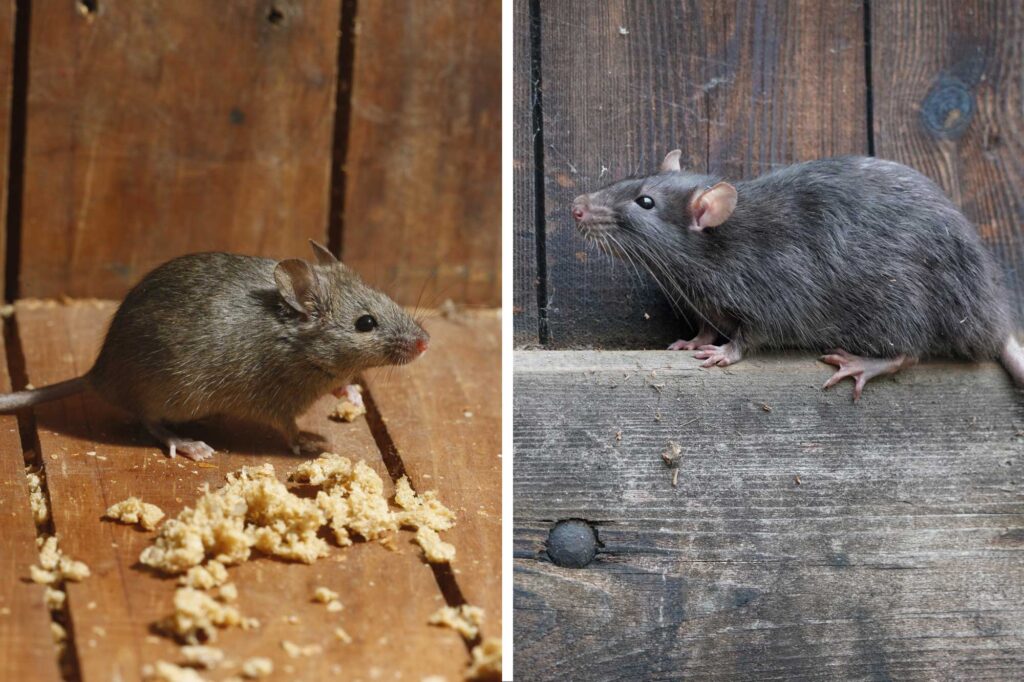
Rats and mice are two of the most common rodents found in urban and rural environments. While they share many similarities, they also have distinct differences that can help in identifying them. Understanding these differences is crucial for effective pest control and management. This article explores the key distinctions between rats and mice, including their physical characteristics, behaviors, habitats, and dietary preferences.
Overview of Mice
Mice belong to the family Muridae and are small rodents commonly found in various environments, including homes, fields, and forests. The most prevalent species is the house mouse (Mus musculus). Mice are known for their adaptability and rapid reproduction.
Physical Characteristics of Mice
- Size: Adult house mice typically measure about 3 to 4 inches (7.5 to 10 cm) in body length, excluding the tail.
- Weight: Mice usually weigh between 0.5 to 1 ounce (15 to 30 grams).
- Appearance: Mice have slender bodies with pointed snouts, large ears, and long, thin tails covered in fine hair.
- Color: Their fur can vary from light brown to gray, often with lighter bellies.
Overview of Rats
Rats are larger rodents that also belong to the family Muridae. The most common species found in urban areas include the Norway rat (Rattus norvegicus) and the roof rat (Rattus rattus). Rats are known for their intelligence and adaptability.
Physical Characteristics of Rats
- Size: Adult rats can range from 7 to 10 inches (18 to 25 cm) in body length, not including the tail.
- Weight: Rats typically weigh between 8 ounces to over 1 pound (225 to 450 grams).
- Appearance: Rats have thicker bodies with blunt snouts, smaller ears relative to their head size, and long tails that are often hairless and scaly.
- Color: Their fur can be brown, gray, or black.
Key Differences Between Rats and Mice
The following table summarizes the primary differences between rats and mice:
| Feature | Mice | Rats |
|---|---|---|
| Scientific Name | Mus musculus | Rattus norvegicus (Norway rat) |
| Average Length | 3 – 4 inches (7.5 – 10 cm) | 7 – 10 inches (18 – 25 cm) |
| Average Weight | 0.5 – 1 ounce (15 – 30 grams) | 8 ounces – over 1 pound (225 – 450 grams) |
| Tail | Long, thin, hairy | Long, thick, hairless |
| Ears | Large relative to head | Smaller relative to head |
| Snout Shape | Pointed | Blunt |
| Behavior | Curious and exploratory | Cautious and wary |
| Diet | Grains, fruits, seeds | Omnivorous; prefers meat and grains |
| Reproduction Rate | High; up to 10 litters per year | Moderate; up to 6 litters per year |
| Lifespan | About 1 year | About 2 years |
Behavioral Differences
Curiosity vs. Caution
One of the most notable behavioral differences between mice and rats is their level of curiosity. Mice are generally more inquisitive and will explore new objects or environments without much hesitation. This trait can make them easier to trap since they often investigate baited traps.In contrast, rats exhibit a higher level of caution or neophobia when encountering new objects or changes in their environment. They tend to avoid unfamiliar items until they have had time to assess them. This cautious behavior makes rats more challenging to trap compared to mice.
Social Structure
Both mice and rats are social animals; however, their social structures differ significantly. Mice can be more solitary or live in smaller groups, while rats often form larger colonies with complex social hierarchies. In rat colonies, dominant individuals may establish territories and engage in social behaviors such as grooming.
Habitat Preferences
Mice
Mice are highly adaptable creatures that can thrive in various environments. They prefer nesting in hidden areas close to food sources, such as kitchens or pantries. Mice can squeeze through small openings due to their slender bodies, allowing them access to many areas within a home.
Rats
Rats tend to prefer lower levels of buildings or outdoor burrows. They often build nests in basements or under debris outside. Unlike mice, rats are less likely to climb into higher areas unless they are roof rats. They require larger openings than mice due to their size.
Diet Differences
Both mice and rats are omnivorous but have different dietary preferences:
- Mice: Typically prefer grains, seeds, fruits, and vegetables. They tend to nibble on various foods but may be more selective than rats.
- Rats: Have a broader diet that includes meat scraps along with grains and fruits. Their less picky eating habits allow them to thrive in diverse environments.
Reproduction
Both species reproduce quickly but differ slightly in their reproductive rates:
- Mice: Can produce up to ten litters per year with an average of six young per litter. They reach sexual maturity at about six weeks old.
- Rats: Typically have fewer litters per year (up to six), with an average of eight young per litter. They reach sexual maturity at around three months old.
Health Risks Associated with Rodents
Both rats and mice pose health risks due to their potential for transmitting diseases through droppings, urine, and bites. Some common diseases associated with these rodents include:
- Hantavirus Pulmonary Syndrome (HPS): Primarily associated with deer mice but can also occur with other rodent species.
- Leptospirosis: Can be transmitted through contact with water contaminated by rat urine.
- Salmonella: Often spread through food contaminated by rodent droppings.
Conclusion
In conclusion, while rats and mice share many characteristics as members of the rodent family, they exhibit significant differences that can help distinguish between them. Understanding these differences—ranging from physical characteristics like size and appearance to behavioral traits such as curiosity levels—can aid homeowners in identifying infestations accurately.Effective pest management relies on recognizing these distinctions so that appropriate control measures can be implemented. Whether dealing with a mouse or a rat infestation, knowing how these rodents behave can lead to more successful prevention strategies and ultimately protect your home from damage caused by these common pests.





